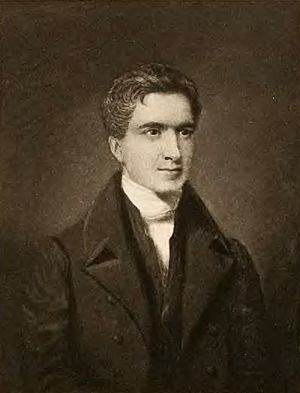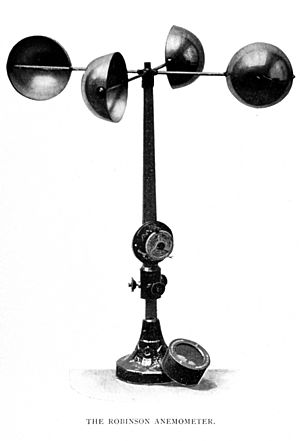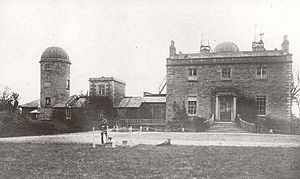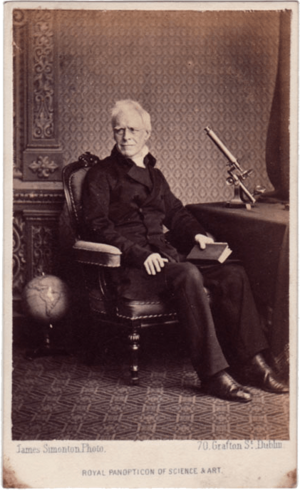Thomas Romney Robinson facts for kids
Quick facts for kids
Thomas Romney Robinson
|
|
|---|---|

Robinson early in life
|
|
| Born | 23 April 1792 |
| Died | 28 February 1882 (aged 89) |
| Awards | Royal Medal (1862) |
John Thomas Romney Robinson (born April 23, 1792 – died February 28, 1882), often called Thomas Romney Robinson, was an Irish astronomer and physicist in the 1800s. He was the director of the Armagh Astronomical Observatory for a long time. This was one of the most important places for studying stars in the UK during his era.
He is best known for inventing the 4-cup anemometer, a device that measures wind speed.
Contents
Early Life and Education
Robinson was born in Dublin, Ireland. His father, Thomas Robinson, was a portrait painter. Young Thomas went to Belfast Academy for school. Later, he studied at Trinity College Dublin. He became a top student there in 1808 and earned his degree in 1810. By 1814, at just 22 years old, he became a fellow at the college. For several years, he also taught natural philosophy (which is what we now call physics) at Trinity.
While at Trinity, he also became an Anglican priest. In 1824, he took on church duties in Enniskillen and Carrickmacross.
Life at Armagh Observatory
In 1823, when he was 30, Robinson was also made the astronomer at the Armagh Observatory. From then on, he lived at the observatory. He spent his life there doing research in astronomy and physics until he passed away in 1882.
Exploring the Night Sky
In the 1840s and 1850s, Robinson often visited the most powerful telescope of its time. This telescope was called the Leviathan of Parsonstown. His friend and fellow scientist, William Parsons, 3rd Earl of Rosse, had built it.
Robinson worked with Parsons to understand the detailed views of the night sky. They especially looked at galaxies and nebulae. Robinson published important research papers about these discoveries.
Back at his own observatory in Armagh, Robinson created a large list of stars. He also wrote many reports about his findings.
Awards and Inventions
In 1862, Robinson received the Royal Medal. This award was for his "Armagh catalogue" which listed 5,345 stars. These stars were observed at the Armagh Observatory between 1820 and 1854. He also won for his papers on building astronomical tools and his work on electromagnets.
Robinson is also famous for inventing the Robinson cup-anemometer in 1846. This device helps measure how fast the wind is blowing.
Leadership and Friendships
Robinson was the president of the Royal Irish Academy from 1851 to 1856. He was also a very active organizer for the British Association for the Advancement of Science for many years.
He was a friend of Charles Babbage, who is known as the "father of the computer." Babbage said that Robinson reminded him of his first idea for a calculating machine.
Family Life
Thomas Romney Robinson was married twice. His first wife was Eliza Isabelle Rambaut, who passed away in 1839. His second wife was Lucy Jane Edgeworth (1806–1897). Lucy was the daughter of the politician Richard Lovell Edgeworth.
Robinson's daughter, Mary Susanna Robinson, married the physicist George Gabriel Stokes. Stokes often visited Robinson in Armagh during Robinson's later years.
Recognition
A crater on the Moon is named "Robinson" in his honor.
Works
- Poems by Thomas Romney Robinson, written between the age of seven and thirteen (1808)
- A system of mechanics, for the use of the students in the University of Dublin (1820)
- Astronomical Observations made at the Armagh Observatory (1829)
- An Account of the Casting of the Great Speculum by the Earl of Rosse (1840)
- On the Effect of Heat in Lessening the Affinities of the Elements of Water (1846)
- On Electro-Magnets (1850)
- Places of 5,345 stars observed from 1828 to 1854, at the Armagh observatory (1859)




